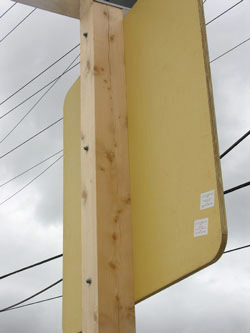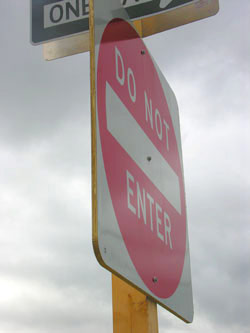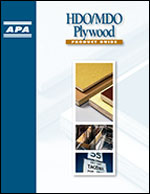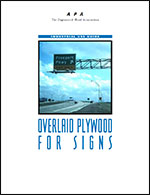
 Highway departments and commercial sign shops across North America specify overlaid plywood panels for signs because they carry the message clearly, deliver the structural properties required of large sign installations and are highly resistant to vandalism and theft. The unique demands of sign construction also require a superior surface that resists peeling, makes for easy application of reflective materials and provides high resistance to edge splitting, slivering and delamination.
Highway departments and commercial sign shops across North America specify overlaid plywood panels for signs because they carry the message clearly, deliver the structural properties required of large sign installations and are highly resistant to vandalism and theft. The unique demands of sign construction also require a superior surface that resists peeling, makes for easy application of reflective materials and provides high resistance to edge splitting, slivering and delamination.
APA trademarked High and Medium Density Overlay (HDO and MDO) plywood effectively combine the toughness of wood structural panels and the superior wear of an overlaid surface. These features place HDO and MDO among the most durable construction materials for signs on the market today. They are ideal in size, strength, weight, dimensional stability and rack resistance. In addition, panels are easy to use, requiring no special machinery or roll systems.
With plywood as the base material, these panels fabricate and install easily, and are resistant to changing temperatures and the effects of moisture. They boast high impact resistance, are readily available and incur low repair and maintenance costs. Overlaid panels also rate high in aesthetic appearance and their use is environmentally friendly.
Always insist on engineered wood products bearing the mark of quality – the APA trademark. This stamp is the manufacturer’s assurance that the product conforms to manufacturing and product performance standards shown on the trademark. The APA trademark only appears on products manufactured by APA members committed to APA's rigorous program of quality inspection and testing.
Publications
 Product Guide: HDO/MDO Plywood
Product Guide: HDO/MDO Plywood
This publication describes High Density Overlay (HDO) and Medium Density Overlay (MDO) plywood applications, properties and characteristics, plus shop practice and finishing recommendations. Demanding applications such as concrete forming, exterior siding and industrial containers require tough building materials. The features of HDO and MDO place them among the most durable construction materials on the market today.

Overlaid Plywood for Signs
This publication describes how to specify MDO and HDO plywood for sign fabrication and provides design details including fastener selection , wind loads, and bracing.
Signage FAQs
APA-member manufacturers are located throughout North America. Hundreds of distribution centers throughout the US and Canada inventory a wide selection of products for signage applications. Industrial users can rely on a consistent source of readily available, quality products. Find APA members that make products for the sign industry.
Overlaid plywood panels are available with some type of face enhancement. Two common face coverings are a Medium Density Overlay (MDO) or High Density Overlay (HDO), which are resin-impregnated fiber surfaces bonded to one or both panel faces under heat and pressure. Other types of enhanced surfaces include fiberglass-reinforced plastic, polyethylene (HDPE), hardboard, metal and other materials for exceptionally smooth or special-use surfaces. The APA product Guide: HDO/MDO Plywood, Form B360, Describes HDO and MDO plywood applications, properties and characteristics, plus shop practice and finishing recommendations.
Sanded plywood panels are structural panels with face and back plies that are sanded smooth in the manufacturing process.
Touch-sanded panels are plywood panels “sized” to uniform thickness by light surface sanding during manufacture. Sander skips are admissible.
A ply is single veneer in a panel. In plywood, a layer consists of one or more adjacent plies having the wood grain in the same direction. For instance, four-ply panels always have three layers with both core plies at right angles to the faces. The two core plies are one layer and each face is a layer. In OSB panels, the reconstituted wood portion is one layer and each face is a layer.
It is important to understand that the term Structural I refers to certain specialized strength and stiffness characteristics of plywood and OSB panels while the term Exposure 1 refers to the glue bond durability of a plywood or OSB panel.
Exterior panels are suitable for applications subject to long-term exposure to weather or moisture.
Exposure 1 panels may be used for applications where construction delays may be expected prior to providing protection. Exposure 1 panels are made with the same exterior adhesives used in Exterior panels. However, because other compositional factors may affect bond performance, only Exterior panels should be used for long-term exposure to weather.
APA Rated Plywood Sheathing Exposure 1, commonly called “CDX” in the trade, is sometimes mistaken as an Exterior plywood panel and incorrectly used in applications for which it does not possess the required resistance to weather. “CDX” is manufactured with a C grade veneer on the face and a D grade veneer on the back. D grade veneers are not suitable for Exterior applications should only be used for applications as outlined under Exposure 1 above. For sheathing grade panels that will be exposed long-term to weather, specify APA Rated Sheathing Exterior (C-C Exterior plywood under PS 1).
APA-trademarked plywood and OSB panels are manufactured to stringent product standards (such as Voluntary Product Standard PS 1, Structural Plywood and Voluntary Product Standard PS 2, Performance Standard for Wood Structural Panels) and under the most rigorous, state-of-the-art quality assurance programs in North America, the APA quality services programs.
Many imported plywood and OSB panels never undergo product qualification testing. Without such tests it is impossible to determine how the panel will perform for the intended use. As an internationally accredited testing laboratory, APA put imported hardwood plywood panels from China and Brazil up against domestic plywood certified to PS 1. As expected, the import test results indicated inferior mechanical and connection properties, severe failure for bond durability, and only one tested sample would have met the formaldehyde limits imposed by CARB when compared to APA-trademarked plywood.
Look for engineered wood panels bearing the APA trademark. It appears only on North American products manufactured by APA members committed to APA's rigorous program of quality inspection and testing.
Learn more about the Performance Panels performance standards.